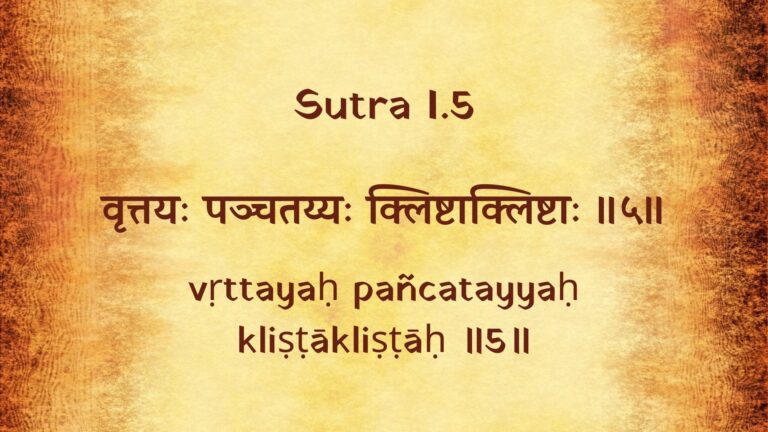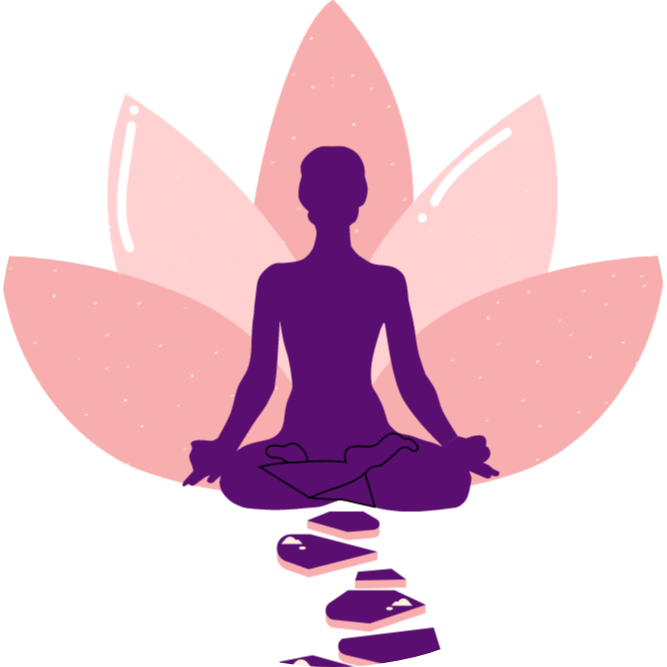Learn Yoga Philosophy
Yoga Sutra I.5

वृत्तयः पञ्चतय्यः क्लिष्टाक्लिष्टाः ॥५॥
vṛttayaḥ pañcatayyaḥ kliṣṭākliṣṭāḥ ॥5॥
The modifications of our mind are of five kinds; and they are either painful or painless.
Yoga Sutra 1.5 helps us further understand ‘vrittis’ or modifications of our mind.
- vṛttayaḥ = vrittis, fluctuations, of the operations, activities, modifications, changes, or various forms (of the mind-field)
- pañcatayyaḥ = five-fold, five kinds, five categories
- kliṣṭā = painful, unpleasant afflicting, tormenting, distressing, connected with pain or suffering
- akliṣṭāḥ = painless, not troubling, undisturbing, unafflicting, not distressful, pleasing
‘Vrittis’ or the modifications of our ‘Chitta’ or mind-field are five-fold and these can be painful or painless. Maharishi Patanjali describes Vrittis in two ways – first by category or kind of vritti and second by the effect that the vritti has on us. The categories of our mental modifications are of five types, and these are named in Yoga Sutra 1.6, which we will discuss in detail next week. In terms of the impact these have, the attention of our mind-field or ‘Citta’ flows either in the direction of activities that lead to pain ‘kliṣṭā’ or those that are pain-free ‘akliṣṭāḥ’. Thus, these five modifications of the mind, can lead you into deep anguish, in ‘dukkha’ or sadness, in misery or if you rightly use this mind and its functioning, it can lead you into non-misery.
These mind fluctuations that arise from what we see, hear, think, feel and experience sometimes cause pleasant and sometimes unpleasant reactions. There is no other state of mind other than these because, if you are awake, you are thinking, and you are a slave to these fluctuations. Every dimension of knowledge, every kind of thought and every field of awareness is one of the vrittis of the mind. These apparent moods of the mind, which are concepts, ideas or images in it, can all be grouped under five categories, irrespective of whether they are experienced as painful or not-painful.
Note the words used in this sutra: “painful or painless.” Maharishi Patanjali doesn’t say that it will lead you into the opposite of pain which we know as pleasure or bliss (Ananda). This is because bliss is your nature; the mind cannot lead you to it. However, when you pause the fluctuations of the mind, and you are in the state of non-misery, your inner bliss starts flowing. Bliss is always there inside; it is your intrinsic nature. You forget that the pleasure you seek is who you already are. You are born with it; you have it already. The truth is that vrittis can either obscure the happiness that is our true nature or leave that happiness undisturbed. The flow toward the painlessness is characterized by clarity, discernment, and selflessness.
The practice of Yoga (Sadhana) through meditation, intention (Sankalpa), selfless action (Karma Yoga), renunciation or non-attachment (Vairagya), study of high ideals (Abhyasa), or chanting mantras help in strengthening the influence of akliṣṭāḥ or painless vrittis in our lives and all of these contribute to Self-realisation.

